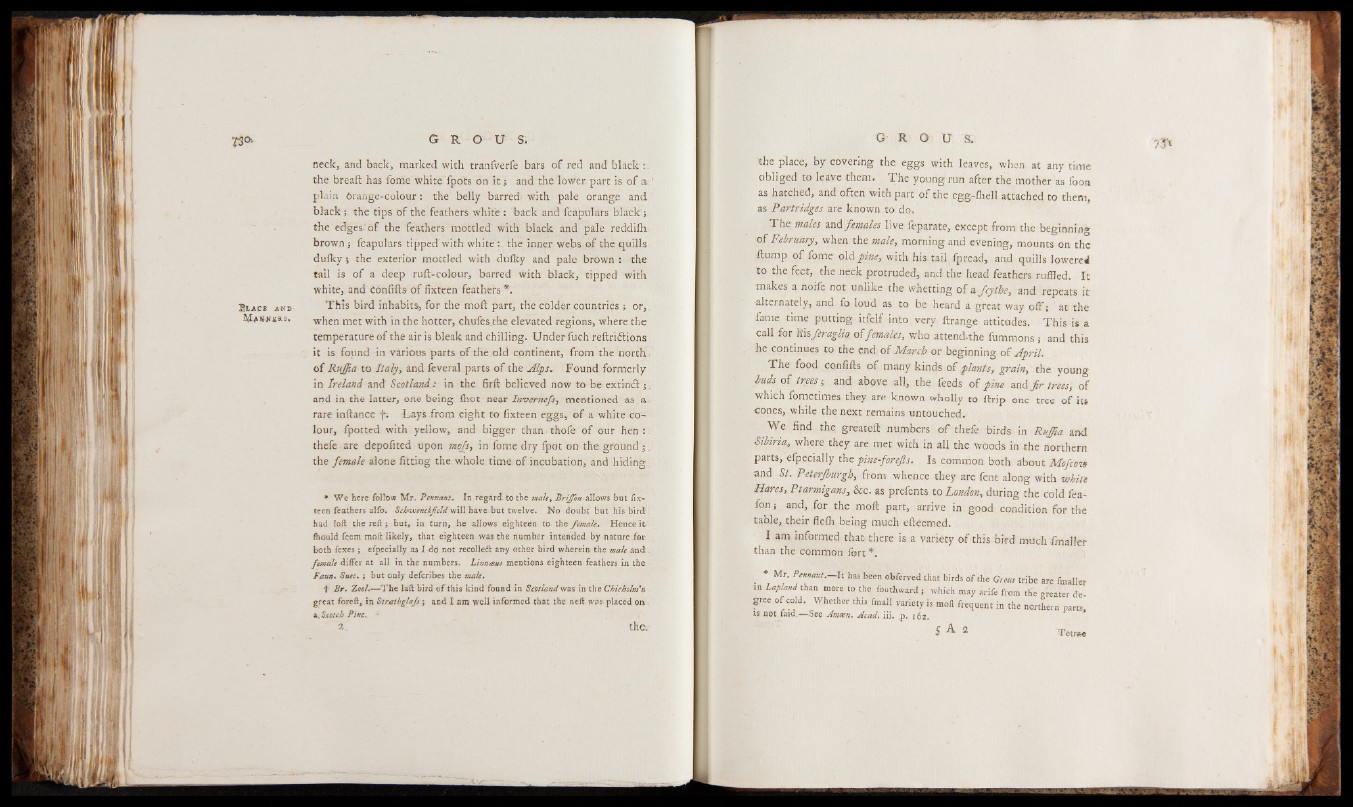
neck, and back, marked with tranfverfe bars of red and blade
the breaft has fome white fpots on i t ; and the lower part is of jjfo
plain Orange-colour: the belly barred, with pale orange and
black; the tips of the feathers white : back and fcapulars black ;
the edges'of the feathers mottled with black and pale reddilh
brown; fcapulars tipped with white the inner webs of the quills
dufky; the exterior mottled with dulky and pale brown ; the
tail is of a deep ruft-colour, barred with black,. tipped with
white, and Confifts of fixteen feathers *.
Siapb and This bird inhabits, for the mod part, the colder countries ; or,
hi**;!!;»?. when met with in the hotter, chufes the elevated regions, where the
temperature of the air is bleak and chilling. Under fuch reftriftions
it is found in various parts of the old continent, from the north I
of RuJJia to Italy, and feveral parts of the Alps. Found formerly
in Ireland and Scotland: in the firft believed now to be extindt;,
and in the latter, one being fhot near Invernefs, mentioned as a
rare inftance f; Lays from eight to fixteen eggs, of- a white colour,
fpotted with;yellow, and bigger than.thofe of our hen::
thefe are depofited upon mofs, in fome dry fpot on the ground ;,
the female alone fitting the, whole time of incubation, and hiding
* We here follow Mr. Pennant. In regard-to the male, BriJJenaMov/s but fix-
teen feathers alto. Sch<w en d f i e ld will have but twelve. No doubt but his bird:
had loft the reft; but, in turn, he allows eighteen to th e female.. Hence it-
fhould feem moft likely, that eighteen was the number intended by nature for
both fexes ; efpecially as I do not recoiled! any other bird wherein the male and .
female differ at all in the numbers. Linn&us mentions eighteen feathers in the
Faun. Suec, ; but only defcribes the male.
t B r . Zocl.— The laft bird of this kind found in Scotland was in the Chicholm'z
great foreft, in Strathglafs; and I am well informed that the neft was placed on
^Scotch Pine.
m the.
'the place, by covering the eggs with leaves, when at anytime
obliged to leave them. The young run after the mother as foot»
as hatched, and often with part of the egg-fhell attached to them,
as Partridges are known to do.
The males and females live feparate, except from the beginning
of February, when the male, morning and evening, mounts on the
flump of fome o\A pine, with his tail fpread, and quills lowered
to the feet, the neck protruded, and the head feathers ruffled. It
makes a noife not unlike the whetting of a Jcythe, and repeats it
•alternately, and io loud as to be heard a great way off; at the
fame -time putting itfelf into very ftrange attitudes. This is a
call for hisferaglio, of females, who attendthe fummons ; and this
he continues to the end of March or beginning of April.
The food confifts of many kinds of plants, grain, the young
huds of trees i and above all, the feeds of pine and fir trees, of
which fometimes they are known wholly to ftrip one tree of its
cones, while the next remains untouched.
We find the greateft numbers of thefe birds in Ruffia and
Siliria, where they are met with in all the woods in the northern
parts, efpecially the. pine-forefts. Is common both about Mofcow
and St. Peterjburgh, from whence they are fent along with white
Hares, Ptarmigans, &c. as prefents to London, during the cold fea-
fon; and, for the moft part, arrive in good condition for the
table, their flefh being much efteemed.
I am informed that, there is a variety of this bird much fmaller
than the common fort *.
; * Mr‘ Pennmt-— 11 been obferved that bird's of the Grms tribe are fmaller
in Lapland than more to the fouthward ; which may arife from the greater degree
of cold. Whether this fmall variety is moll frequent in the northern parts,
is not laid.— See Atrnxn, Acad, iii, .p, 162.
S A 2 Tetra©